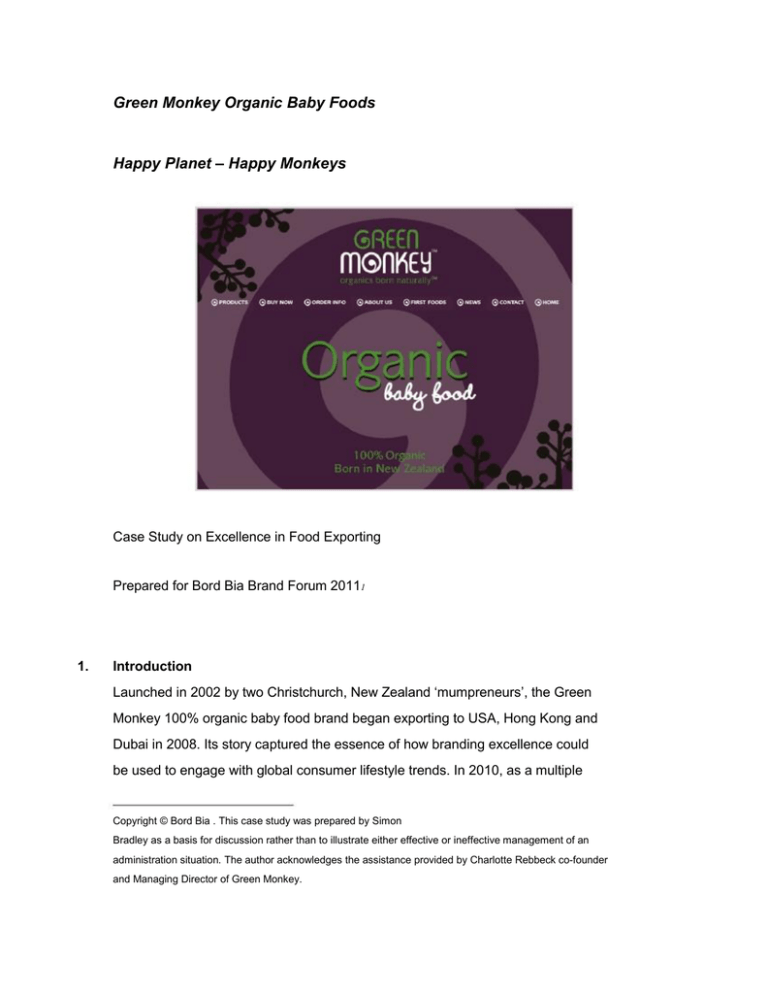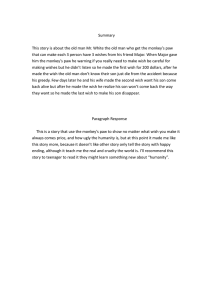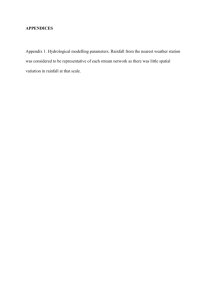Green Monkey Organic Baby Foods Happy Planet – Happy Monkeys
advertisement

Green Monkey Organic Baby Foods Happy Planet – Happy Monkeys Case Study on Excellence in Food Exporting Prepared for Bord Bia Brand Forum 20111 1. Introduction Launched in 2002 by two Christchurch, New Zealand „mumpreneurs‟, the Green Monkey 100% organic baby food brand began exporting to USA, Hong Kong and Dubai in 2008. Its story captured the essence of how branding excellence could be used to engage with global consumer lifestyle trends. In 2010, as a multiple Copyright © Bord Bia . This case study was prepared by Simon Bradley as a basis for discussion rather than to illustrate either effective or ineffective management of an administration situation. The author acknowledges the assistance provided by Charlotte Rebbeck co-founder and Managing Director of Green Monkey. award-winning food exporter, Green Monkey Company Ltd faced a new set of challenges and opportunities in the global marketplace compared to when it started selling through local supermarkets and health shops. Despite the business transformation, company founders Lizzie Dyer and sister Charlotte Rebbeck (Appendix 1) ensured the Green Monkey brand remained true to its founding principles. 2. Monkey Business When two year-old Amelia Dyer became a picky eater, her mother Lizzie began researching mainstream baby food brands she had been feeding her child. In light of her observations, Dyer felt sure there was a clear opportunity to create a wholesome, nourishing baby foods business based only on the purest and most natural of ingredients with no added sugar, salts or preservatives, for example. In her words, „mashed pumpkin should be just pumpkin‟. The ethos was simple yet challenging: all products would be 100% organic, traceable and sourced exclusively from certified New Zealand producers. It was a truly unique selling proposition – no other baby food brand in the New Zealand market could make that claim. Having travelled extensively and witnessed the evolution in organic lifestyles in Europe and USA, Rebbeck was confident they were tapping into global trends. To her mind, a significant group of people were increasingly concerned about the source and healthiness of their foods. The sisters also believed they could further benefit from country-of-origin perceptions, believing “whatever is clean, green and from New Zealand, sells”. Inspiration for the company name came from Rebbeck‟s nephew who would call her a green monkey when she teased him in return. The name „Green Monkey‟ seemed a perfect fit for an organic baby food brand. With the help of business classes and mentoring the pair formulated a plan. Initial product development centred on frozen food products. Made in batches at a 2 commercial kitchen in Christchurch, Green Monkey created two product varieties: seasonal vegetables and seasonal fruits. Packaged as individual portions in cartons, each box contained 12x30 gram servings that could be eaten when thawed or after heating (Appendix 2). Products gained local then later national distribution through supermarket chains. The sisters benefited significantly from the product‟s quality and the inherent „talkability‟ of their business story - being two New Zealand female entrepreneurs starting up a 100% organic New Zealand food business. They gained valuable publicity and credibility from coverage in various categories of magazine and newspapers. As a niche brand, unique in its category, there was much ado about Green Monkey among New Zealand customers (Appendix 3). 2. Impetus for change Management at Green Monkey had always intended on internationalising. Apart from trends toward organic lifestyles, the limited size of the domestic market made it necessary to seek foreign markets. With 35,000 babies born every year in New Zealand, Green Monkey‟s super-premium positioning limited its target market to about 10% of Kiwi babies. Subsequent research characterised customers as “educated people who are time-deprived and know about the importance of good food”. Management believed this was an international market segment, not just a New Zealand phenomenon. 3. Happy Planet, Happy Monkeys Despite the enhanced profile and sales success, Green Monkey faced several challenges with its marketing mix. These included in-store product visibility, reduced distribution opportunities and a frozen-food product dependent on a reliable cold-chain distribution system. By 2006, daily output was approximately 50-60 boxes and it was clear to management that marketing mix issues aside, the business would need help with funding an export drive. 3 With matching-grant support from Canterbury Development Corporation and New Zealand Enterprise management wrote an export plan and researched organic certification and compliance issues – deemed critical for export branding. The sisters also partnered with Andy Macbeth, former CEO of Cookie Time; a successful New Zealand food business. With Macbeth onboard as part-owner, Dyer could pull back from daily management and Rebbeck could focus on operations while Macbeth concentrated on strategic development. Performing a review, management identified several key success factors (KSFs) to support its export drive: streamlined costs and a revised marketing mix, specifically marketing communications and new product innovation. 3.1 New Business Model To achieve flexibility, Green Monkey adopted a business model based on the value network concept – different aspects of the value chain would be outsourced to approved partners, thereby lowering overheads. Essentially Green Monkey would become a marketing company instead of a manufacturer. 3.2 New Product Development Innovation in the product range was profound yet simple. Green Monkey switched to ready prepared meals innovatively packaged in thermally-sealed pouches that could be eaten „on-the-go‟ or lightly heated in the pouch (Appendix 4). The company also focused on vegetable based meals that could transcend cultural and personal eating preferences and keep costs in check. Feedback from potential customers at a Food Fair in Queenstown in 2007 gave them confidence to pursue this unique positioning, using pouches. Three entirely new recipes were created – (Appendix 5), each packaged in its own colour-coded pouch. The innovative packaging system offered a number of advantages being distinctive, sturdy and giving the food a 12-month shelf life from the date of packaging. It could also be mailed directly to individual buyers for sampling or for personal consumption. 4 3.3 Marketing Mix The core brand proposition was compelling but needed tweaking in its marketing mix and communications methods. The firm would continue with suepr-premium pricing. Meanwhile it was decided to continue investing in the brand‟s „talkability‟ through press and paid print media (Appendix 6). That included building credibility and provenance by competing in various food and business awards programs, but also investing in ways to reach and engage an international audience cost-effectively. As part of this, a new tagline was devised to capture the brand‟s mission, “Happy Planet, Happy Monkeys”. Updating and optimising the company‟s website was prioritised, adding an ecommerce facility and investing in online marketing (Appendix 7). It was the best way to reach a dispersed and international audience while controlling the brand‟s message. Search engine optimisation and search marketing ensured visibility, quickly assuming number one spot in searches on Google for organic baby food in 2008. Online marketing quickly generated consumer level sales and business level queries from international customers. 3.3 Market Selection Management also worked with New Zealand Trade and Enterprise to identify and select foreign markets, contacting potential distributors and retailers. These activities combined with online marketing generated queries from parties in USA, Australia, Dubai and Hong Kong. The reasons for selecting each country differed market to market. Reflecting on the Australian market, Rebbeck noted it “was never really on our hit list, but they‟re currency is really strong at the moment so our trading with them is easier and better for us”. Similarly, cultural and linguistic similarities combined with sophisticated and sizeable demand for organic products made the USA initially a very attractive destination. Rebbeck was convinced middle-class Chinese consumers were interested in and prized organic foods from New 5 Zealand driven by a growing distrust of local food quality due to various food scandals in recent history. The company partnered with two locally based agents to act as its Chinese distributors. Both men had attended university in the west were bilingual and were actively looking for international business opportunities in foods to import to China. In Dubai, country of origin effect was a catalyst. 4. Results from Export Expansion The decision to export entailed a new set of skills distinct to brand building in the domestic market. Commenting on issues such as planning, currency controls and managing stock levels, Macbeth explained, “NZTE helped us to a certain degree, acting as facilitators and making introductions – but beyond this, it‟s up to us as exporters to solve the more practical issues”. There were also labelling, payment terms and negotiations to address. Green Monkey product information was printed directly onto packs and each market had different requirements. Negotiations required face-to-face meetings, meaning Rebbeck travelled extensively to close deals and maintain relationships. To minimise various export risks, payment before dispatch was mandatory. In Australia it took the company three attempts to secure the right distributor. By 2010 the company had grown more committed to developing its Australian presence. Without its Chinese partnerships to nurture and develop relationships all along the distribution chain, management would never have attempted a Chinese market entry. Meanwhile the scale and nuances of the US market made finding the right partner critical. This was especially pertinent for a small firm negotiating quarterly purchases comparable to its annual domestic output volume. Green Monkey‟s flexible structure allowed it to pitch for and prepare for such deals with minimal disruption to operations and working capital flows. 6 But Green Monkey withdrew from the USA in 2010. The purchasing structures in retail proved too costly for a small brand, involving multiple intermediaries including agents, brokers and distributors. Further, a trend toward price competition including rebates and sensitive price points made marketing a highquality brand such as Green Monkey impossible without compromise to the core product. In 2009, exports accounted for about 50% of Green Monkey‟s multi-million dollar turnover. Management‟s goal was to increase that contribution to 90%. As Green Monkey prepared to enter the EU market in 2011, that had been achieved despite having withdrawn from the US. Management began looking to establish the best strategy for approaching the EU without neglecting its more developed markets. With the 2011 Rugby World Cup due to take place in New Zealand, the company faced a significant marketing opportunity to reach out to target audiences from a number of different regions worldwide. A question for Rebbeck and Macbeth was how to tie that in with their more immediate plans for tackling the EU. 5. Key Lessons from Green Monkey • Indirect exporting combined with online marketing was the best internationalisation option available to an SME like Green Monkey. It allowed management to control the brand message while expanding with minimal cost and risk. • This was supported by maintaining control over cash-flows and investing continuously in the brand. The strategic overhaul in 2006-2008 was critical to this success. • Management remained true to the brand vision while transforming its business model, marketing communications and product. • Winning New Zealand‟s prestigious Massey Export award in 2008 among other accolades (Appendix 8) since its repositioning had also helped raise Green Monkey‟s profile and prospects in new untapped markets. 7 6. Appendices Appendix 1: Lizzie Dyer, Amy Dyer and Charlotte Rebbeck circa 2004 Appendix 2: Original Green Monkey packaging Appendix 3: Press coverage helped in early marketing. 8 Appendix 4: Innovative Pouch System Appendix 5: New Green Monkey Range Front and Back 9 Flavours Include: • Purple: Apple and Blueberry • Orange: Carrot and Parsnip • Green: Pumpkin, Silverbeet and Potato Appendix 6: Flyers Appendix 7: Green Monkey website and online shop 10 Appendix 8: Green Monkey awards 1. 2008 Winner of three gold Massey Food Awards. 2. 2008 Winner of OANZ- Organic Enterprise Award. 3. 2009 Winner of two gold awards at Australian Food Awards. 4. 2009 Innovative Business Award Winner at the David Awards New Zealand. 11






